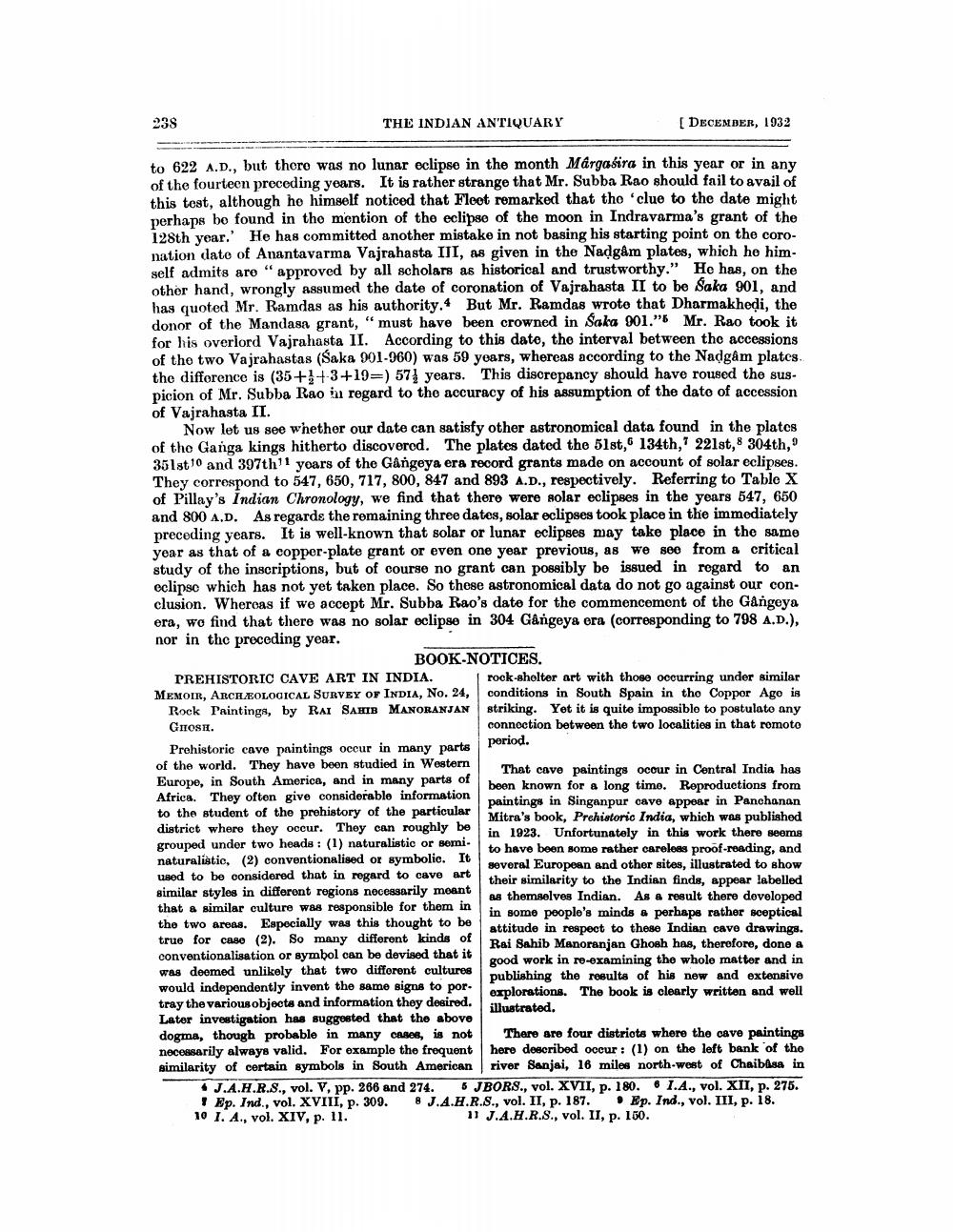________________
238
THE INDIAN ANTIQUARY
( DECEMBER, 1932
to 622 A.D., but there was no lunar eclipse in the month Mârgasira in this year or in any of the fourteen procoding years. It is rather strange that Mr. Subba Rao should fail to avail of this test, although he himself noticed that Floot remarked that tho clue to the date might perhaps bo found in the mention of the eclipse of the moon in Indravarma's grant of the 128th year.' He has committed another mistake in not basing his starting point on the coronation date of Anantavarma Vajrahasta III, as given in the Nadgám plates, which he himself admits aro "approved by all scholars as historical and trustworthy." He has, on the other hand, wrongly assumed the date of coronation of Vajrahasta II to be Saka 901, and has quoted Mr. Ramdas as his authority. But Mr. Ramdas wrote that Dharmakhedi, the donor of the Mandasa grant, "must have been crowned in Saka 001." Mr. Rao took it for his overlord Vajrahasta II. According to this date, the interval between the accessions of the two Vajrahastas (Šaka 001-960) was 59 years, whereas according to the Nadgâm plates. the difference is (35+1+3+19=) 574 years. This discrepancy should have roused the suspicion of Mr. Subba Rao in regard to the accuracy of his assumption of the date of accession of Vajrahasta II.
Now let us see whether our date can satisfy other astronomical data found in the plates of the Ganga kings hitherto discovered. The plates dated the 51st,6 134th, 221st, 304th, 9 351st 10 and 397th! yoars of the Gangeya era record grants made on account of solar eclipses. They correspond to 547, 650, 717, 800, 847 and 893 A.D., respectively. Referring to Table X of Pillay's Indian Chronology, we find that there were solar eclipses in the years 547, 650 and 800 A.D. As regards the remaining three dates, solar eclipses took place in the immediately preceding years. It is well-known that solar or lunar eclipses may take place in the same year as that of a copper-plate grant or even one year previous, as we see from a critical study of the inscriptions, but of course no grant can possibly be issued in regard to an eclipse which has not yet taken place. So these astronomical data do not go against our conclusion. Wheroas if we accept Mr. Subba Rao's date for the commencement of the Gangeya era, wo find that there was no solar eclipse in 304 Gångeya era (corresponding to 798 A.D.), nor in the proceding year.
BOOK NOTICES. PREHISTORIC CAVE ART IN INDIA. rock-shelter art with those occurring under similar MEMOIR, ARCHAEOLOGICAL SURVEY OF INDIA, No. 24, conditions in South Spain in the Coppor Age is
Rock Paintings, by RAI SAHIB MANORANJAN striking. Yet it is quite impossible to postulate any Grosu.
connoction between the two localities in that remoto Prehistoric cave paintings occur in many parts
period. of the world. They have been studied in Western
That cave paintings ocour in Central India has Europe, in South America, and in many parts of
been known for a long time. Reproductions from Africa. They ofton give considerable information
paintings in Singanpur cave appear in Panchanan to the student of the prehistory of the particular
Mitra's book, Prehistoric India, which was published district where they occur. They can roughly be
in 1923. Unfortunately in this work there seems grouped under two heads : (1) naturalistic or semi.
to have been some rather careloas proof-reading, and naturalistic, (2) conventionalised or symbolic. It
several European and other sites, illustrated to show used to be considered that in regard to cave art
their similarity to the Indian finds, appear labelled similar styles in different regions necessarily meant
as themselves Indian. As a result there developed that a similar culture was responsible for them in
in some peoplo's minds a perhaps rather sceptical the two areas. Especially was this thought to be
attitude in respect to these Indian cavo drawings. true for caso (2). So many different kinds of
Rai Sahib Manoranjan Ghosh has, therefore, dono a conventionalisation or symbol can be devised that it
good work in re-examining the whole matter and in was deemed unlikely that two difforent cultures
publishing the results of his new and extensive would independently invent the same signs to por
explorations. The book is clearly written and well tray the various objects and information they desired.
illustrated. Later investigation has suggested that the above dogma, though probable in many cases, is not There are four districts where the cave paintings necessarily always valid. For example the frequent here described oocur: (1) on the left bank of the similarity of certain symbols in South American river Sanjai, 16 miles north-west of Chaibasa in
* J.A.H.R.S., vol. V, pp. 266 and 274. 5 JBORS., vol. XVII, p. 180.6 1.A., vol. XII, p. 275.
! Ep. Ind., vol. XVIII, p. 309. J.A.H.R.S., vol. II, p. 187. Ep. Ind., vol. III, p. 18. 10 I. A., vol. XIV, p. 11.
11 J.A.H.R.S., vol. II, p. 150.




